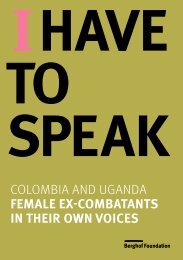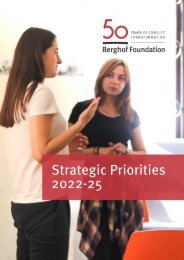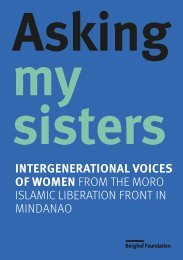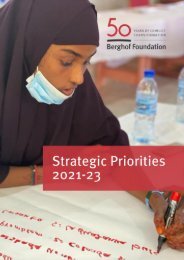Berghof Foundation: 50 years of conflict transformation
This book provides an overview of the Berghof Foundation’s work and impact over the past 50 years and sheds light on the challenges ahead of peacebuilding.
This book provides an overview of the Berghof Foundation’s work and impact over the past 50 years and sheds light on the challenges ahead of peacebuilding.
Create successful ePaper yourself
Turn your PDF publications into a flip-book with our unique Google optimized e-Paper software.
Going global<br />
2000–present<br />
Applying our peace<br />
education approaches<br />
in other contexts<br />
Children from different communities in Kenya playing as a unified team.<br />
Photo: Frank Schultze / Peace Counts<br />
If you are looking for the address <strong>of</strong> Peace Education<br />
in Germany, you will come across the Georg Zundel<br />
House <strong>of</strong> the <strong>Bergh<strong>of</strong></strong> <strong>Foundation</strong> in Tübingen.<br />
Since 2002, this building has been the home <strong>of</strong> the<br />
former Institute <strong>of</strong> Peace Education, founded in<br />
1976 as an association <strong>of</strong> peace activists, peace<br />
researchers, teachers and social workers. Under its<br />
ro<strong>of</strong>, regular expert meetings and conferences have<br />
promoted and influenced Peace Education theory<br />
discourses and education practices in Germany. A<br />
wide range <strong>of</strong> publications and multimedia materials<br />
for researchers, teachers, social workers and the<br />
general public have been produced and countless<br />
school classes, student groups and others have<br />
come to the Georg Zundel House for interactive<br />
workshops, encounters and dialogues on peace,<br />
<strong>conflict</strong>, violence and war.<br />
Since 2000, we have expanded our peace<br />
education work to a number <strong>of</strong> other countries<br />
around the globe. One programme that was<br />
particularly groundbreaking in this regard was ‘Peace<br />
Counts’, a multimedia exhibition we developed<br />
together with journalists about peacebuilders around<br />
the world to counter the overwhelming presence <strong>of</strong><br />
war and violence in the media. The journalists’ reports<br />
portrayed inspiring people around the world and their<br />
efforts to reconcile, overcome hatred and initiate<br />
social change in <strong>conflict</strong> regions.<br />
Our Peace Education team designed the<br />
exhibition, multimedia materials and accompanying<br />
education programmes for school classes in<br />
Germany. They trained university students to<br />
facilitate workshops where young people discussed<br />
the biographies <strong>of</strong> the portrayed peacebuilders and<br />
reflected on the values <strong>of</strong> peace, nonviolence and<br />
reconciliation and their own capabilities for change.<br />
After hundreds <strong>of</strong> school classes took part in the<br />
programme in Germany, the team took the exhibition<br />
to other countries where peacebuilders work with<br />
the aim <strong>of</strong> inspiring others. The travelling exhibition<br />
was first shown in Sri Lanka in 2007, followed by<br />
Macedonia, Côte d’Ivoire, Russia, Philippines, India<br />
and Colombia. In all cases, the exhibition project was<br />
carefully prepared and implemented together with<br />
local partners.<br />
In selected countries, we <strong>of</strong>fered more indepth<br />
training and supported local partners to enable<br />
them to work independently with the exhibition,<br />
adapt or translate the materials and provide their<br />
own training and workshops. These ‘training for<br />
trainers’ events also included methodologies for<br />
peace education, integrating education about peace<br />
(peace as a topic), for peace (peace as the goal)<br />
and through peace (educating by peaceful means).<br />
Networks <strong>of</strong> trainers formed in Northeast India, in<br />
the South Caucasus and in Iran, <strong>of</strong>ten from different<br />
communities. They organised poster exhibitions and<br />
facilitated their own workshops at universities and<br />
schools in a number <strong>of</strong> communities and remote rural<br />
areas, thus reaching out to thousands <strong>of</strong> people.<br />
In many countries, the Peace Counts exhibition<br />
project has been the starting point for deeper and<br />
longer-term collaborations on peace education. In<br />
order to make sustainable achievements, efforts<br />
for structural changes in the education system<br />
and its curricula are needed. In Northeast India,<br />
local universities have integrated the Peace<br />
Counts programme into their regular curricular or<br />
extracurricular activities. In Jordan, this project<br />
was an entry point for a seven-year programme<br />
<strong>of</strong> cooperation with education institutions on<br />
developing civic and nonviolent education in schools,<br />
universities and refugee camps. Storytelling<br />
approaches from the Peace Counts programme<br />
were then complemented by further methodologies<br />
such as street football for tolerance and interactive<br />
theatre. In Jordan, we developed a curriculum<br />
on civic and nonviolent education with university<br />
pr<strong>of</strong>essors, deans and students all over the country<br />
in cooperation with the Ministry <strong>of</strong> Higher Education.<br />
Peer mediation was yet another approach that<br />
Jordanian teachers who had attended in our<br />
training course on this topic in Germany took up and<br />
implemented in their schools.<br />
Having the Georg Zundel House as our<br />
‘home base’ and being able to invite our partners<br />
from abroad was key to the success <strong>of</strong> our work.<br />
From 2013 to 2017, it allowed us to bring together<br />
young people from our projects in India, Jordan, Iran,<br />
South Caucasus and other regions <strong>of</strong> the world at<br />
our annual Summer School for Young Peacebuilders<br />
to share their experiences, learn from each other,<br />
motivate one another and form a network <strong>of</strong> people<br />
working on peace education and related fields. The<br />
special atmosphere <strong>of</strong> the Georg Zundel House as a<br />
space <strong>of</strong> encounter and learning is something that all<br />
participants cherish and has led many <strong>of</strong> them to stay<br />
connected over the <strong>years</strong>.<br />
Meanwhile, our development <strong>of</strong> sustainable<br />
structures for peace education within Germany<br />
continues. The Service Centre for Peace Education,<br />
established in 2015 by the Ministry <strong>of</strong> Education in<br />
Baden-Württemberg, the State Agency for Civic<br />
Education and the <strong>Bergh<strong>of</strong></strong> <strong>Foundation</strong>, has become<br />
a visible sign <strong>of</strong> institutionalisation <strong>of</strong> peace education<br />
and <strong>of</strong> cooperation between state institutions and<br />
civil society. The Service Centre <strong>of</strong>fers teacher<br />
training, multimedia materials and workshops for<br />
schools and creates a network <strong>of</strong> model schools for<br />
peace education. They now work with an updated<br />
version <strong>of</strong> the Peace Counts exhibition produced in<br />
2020. This interconnectedness <strong>of</strong> our local and global<br />
work has been a great source <strong>of</strong> mutual inspiration<br />
and our work and experience at home give us<br />
credibility vis-à-vis our partners in other countries.<br />
102<br />
103










